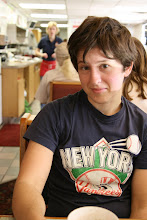
Dear you,
I was thinking about loneliness and all of its recent conversational outcroppings and the sadness that comes with it. Both of us are people that engage with daily alone-ness and are good at being okay about it. But we've also talked about how the word is problematic because not only is it possible to feel lonely in the company of others but because it is possible to be fully satisfied in the presence of no one. So of course I looked it up. Merriam Webster dictionary writes that the state of being lonely can mean any of four things: 1) being without company, cut off from others 2) not frequented by human beings 3) sad from being alone 4) producing a feeling of bleakness or desolation. The definition doesn't leave room for content loneliness... which was disappointing until I read this by Paul Tillich:
"Language has created the word 'loneliness' to express the pain of being alone. And it has created the word 'solitude' to express the glory of being alone." So of course I looked up some other words and thought about how tricky but essential their differences are-- for example, 'isolation' being a detachment and 'seclusion' being a deliberate withdrawal.
Words have been and will always continue to bewilder. I started crying this morning in front of my advisor James while we were talking about frames. I kept trying to tell him that he shouldn't worry because it wasn't about the frames-- he was certain that he said something to the highest degree of personal offense. I am certain I could have said something that would have been adequate, but I kept catching the words before they came out of my mouth, stunned by their inadequacy-- you know, things like "I'm okay" and "I don't know"-- expressions that short-thrift what's actually going on. I was feeling very lost in that moment about who I was making my art for-- it seemed (in the moment and still now) impossible to figure out. I'm in my studio all day, alone, thinking and making things which will eventually live in a space (and eventually, a world) without me to explain them. But I also feel very much not alone-- I feel responsibility to make things that matter, that will make my family proud, that will speak about issues greater than my ability to articulate. Of course, this relates to the impossibility of trying to figure out what's best for me as autonomous from the world-- because I feel so intrinsically linked to everything else, and this sometimes means to you too.
There are many different kinds of being lonely-- in fact, probably each one is entirely unique. I think that the loneliness of one moment is so totally shape-shifting that by the time you are ready to process it, it has already turned into another kind of loneliness. Sort of like how I told you that it seemed impossible to me to live in the "here and now" because the 'right-now' is just the corner between the past and the future. T.S. Eliot was probably getting at this when he penned the question
"What loneliness is more lonely than distrust?" He's admitting that there is more than one kind. In this quotation it seems to me that the distrust he is talking about isn't just something like having distrust in a person... for me he is talking about something more general, like uncertainty. To be uncertain requires a sort of detachment from certainty/sureness/confidence, and to be detached means to be, in any of various ways, alone.
I trust that everyone (not just you, not just me, not just twenty-year olds everywhere) oscillate/vacillate between being lost and being found on a hourly/daily/weekly/seasonal rotation. This makes sense-- that we experience and that then we attempt to evaluate those experiences. But how does one make sense of needing to be alone one moment and needing to be with others the next? I was heartened by this question and answer from the mouth of Kurt Vonnegut:
"What should young people do with their lives today? Many things, obviously. But the most daring thing is to create stable communities in which the terrible disease of loneliness can be cured." I'm comforted by this because this seems like a good strategy and because I understand his use of the words 'stable' and 'communities' to mean something more like 'supportive' and 'environments.' 'Stable' is sort of scary to because it almost means 'predictable' and 'community' is scary because it seems to imply a presence amongst 'many people.'
I'm almost done writing this letter, but haven't reached any sort of conclusion-- I sort of feel like one of those french bulldog puppies stuck in the air with my soft little legs pawing in the air. When we were watching that video I was mesmerized by the juxtaposition of the desperate pace of those outstretched legs while the puppy scrambled to upright itself abbreviated and then by the calm stillness while it caught it's breath, the vulnerability of it's naked freckled belly arched towards the ceiling and it's dark eyes slowly scanning the room for someone to come help turn it over.
See you soon,
me
 I spent a lot of time today doing research for my thesis and a piece of writing I'm working on. The main website I looked at was for The Memory Disorders Project at Rutgers University, primarily scrolling through their glossary to learn some new words. I really liked this entry and have been thinking about it this afternoon:
I spent a lot of time today doing research for my thesis and a piece of writing I'm working on. The main website I looked at was for The Memory Disorders Project at Rutgers University, primarily scrolling through their glossary to learn some new words. I really liked this entry and have been thinking about it this afternoon:
























